Two into one does go
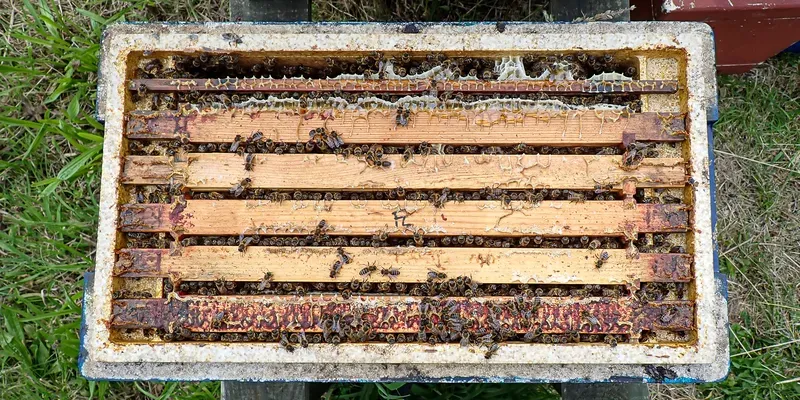
In a normal season I expect to reduce my hive inspection frequency after the mayhem of May and June are over. Once the summer nectar flow starts in earnest, colonies seem to focus on that rather than on swarming. Most of my swarm control, queen rearing and requeening is over for the season, so I can relax a little.
In a normal season.
Of course, it's not really mayhem, it just looks like that 😉. Controlled chaos might be a better term, hopefully with the emphasis on controlled.
It just sometimes looks and feels like mayhem.
But this season is different for a number of reasons. First and foremost, the weather has been playing silly blighters since April (or earlier). The combination of cool northerlies with rain delayed swarming by many colonies, and played merry hell with queen mating.
Although the poor weather delayed swarming, it did not delay swarm preparations.
Time and again I'd open boxes to find mature queen cells and the marked 2022 or 2023 queen still laying perfectly well. On other occasions, too numerous to count (and all merging into one in my memory now), I'd find the marked, clipped queen with one or more virgin queens scuttling around.
Piping queens in cells? Yes, those too. Several times.
Swarm control seemed pretty futile when conditions were too poor for queen mating.
Colonies that did swarm - and I know I lost a couple which is relatively unusual for me - seemed to take forever to get the replacement queen mated.
And, in parallel to my production hives, my grafted queens in 3-5 frame nucs were doing precisely nothing for weeks at a time.
My first round of queen rearing was a washout. Literally. The second and third rounds ended up being merged into one. Grafting and cell raising was straightforward, but 'rain stopped play' and queen mating took weeks.
Postponing the inevitable
All of which meant that by early-July my notes were filled with comments like "No eggs. Final decision next week."
Instead of reducing my inspection frequency - because all the boxes were queenright, swarming was over and my only worry was having enough 15 kg buckets for the honey harvest - I was still searching for eggs every week.
Usually in the rain.
But bees have been around for millions of years, so there's no chance they would be thwarted by a spot of adverse weather or an impatient beekeeper.
Eventually, like it usually does, things seems to have worked out.
And in the middle fortnight in July, everything pretty much came good.
Not perfect - I'm a beekeeper, so there's always something I can complain about - but a whole lot better than it might have been.
The wind blew from a warmer quarter, the rain abated, the sun came out and the nectar flowed.
By golly, the nectar flowed 😄.
Flax?
For the first time I can remember there's a big field of flax near my main apiary. A little Google-Fu suggests that flax (linseed; Linum usitatissimum) is not a great source of nectar. However, the summer flow is earlier than expected, and I've not seen much else about.
Do any readers have practical experience of flax/linseed as a nectar source? A contact tells me that there may be a lot more grown in the future.
The lime, of course, seems to have been a failure ... but that's to be expected 😞.
Anyway, back to the point of the story. Whilst not exactly "snatching victory from the jaws of defeat" things seemed to have largely worked out.
I've got some reasonably heavy supers and more than enough nucs containing mated queens.
Result 😄.
So, although the beekeeping isn't finished for the year, I'm into the 'home straight'. There's the honey harvest in a fortnight or so, then feeding and treating.
Since I don't want to feed and treat colonies I don't need or want, the current focus is on consolidating colonies. In addition, I'm moving house {{1}} and, in due course, want to minimise the number of colonies I subsequently have to move.
Swarm update
Before discussing how to unite nucs and full hives I thought I'd provide a quick update on the two swarms I mentioned in Swarms, lost and found.
The swarm I know I lost, which ended up bivouacked 20 metres up in a cypress tree, stayed there for a couple of days of truly awful weather and then - on the first warm/dry day - disappeared for pastures new.
My bait hive, set up very much after the fact {{2}}, was completely ignored (as I suspected it would be, but it's always worth a try).
I hope they survive and found a bait hive from another Fife beekeeper.
The swarm that moved into my bait hive in the association apiary on the 30th of June was collected by a bee-less association member the following evening.
For three weeks there were no eggs and no sign of a queen, but the bees were calm, so I suspected there was a queen present. I fielded a couple of emails from their new 'owner', the last of which questioned whether a new queen should be purchased.
Fortunately, a day or two later (on the 24th of July) there were eggs.
The swarm, which was a pretty good size, was therefore a cast, headed by a virgin queen. It took her at least three weeks from the swarm arriving to get mated and start laying.
Have patience!
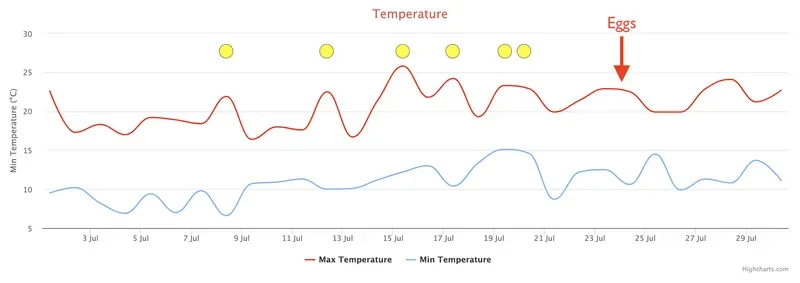
For completeness, here's a graph of the local temperature during July. The first half of the month was generally cool. The queen needs to first go on several orientation flights, and then takes multiple (usually) mating flights, often on successive days. These didn't occur until the middle of the month.
One good day is not enough.
Poorly mated queens
If the queen only gets limited chances to mate you may find that the colony attempts to supersede her within a few weeks {{3}} of her starting to lay. Typically, you'll find the queen present and laying, but also find a few queen cells as well.
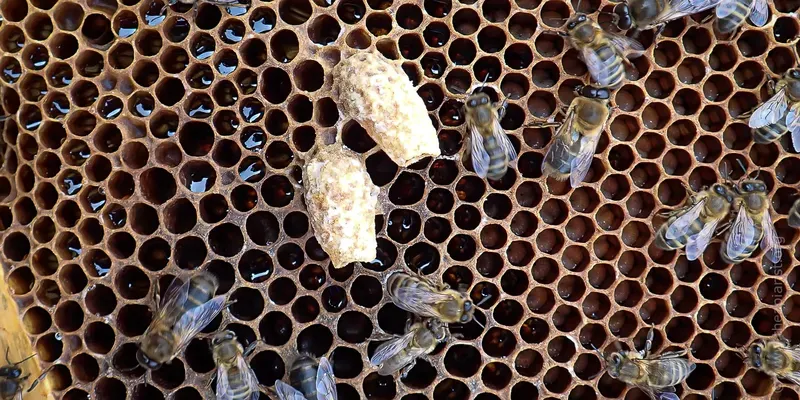
How do you distinguish between a colony attempting to supersede the queen, and one intent on swarming?
Tricky.
The number and position of the queen cells is supposed to be indicative; cells on the periphery of the frame suggest swarm preparations, whereas just one or two cells in the middle of the face of a brood frame indicate supersedure.
Perhaps.
However, I'd always try to take other facts/observations into consideration as well.
If the colony is not very strong, then swarming is less likely. Conversely, if I find a solitary queen cell - wherever it's located - in a colony overflowing with bees and with 11 frames of sealed brood, my first thought is not that they're trying to supersede, it's 'Yikes! Do I have a spare nuc with me?'
Several of my colonies that requeened themselves during swarm control ended up with poorly mated queens. These colonies had built up very strongly early in the season and started to make swarm preparations. Because this was before I'd started queen rearing (so had no spare mated queens), I used the nucleus method of swarm control and allowed the box to rear a new queen.
But the weather was poor and these queens, if they did get mated, were pretty unconvincing. A couple were superseded sometime in June (not always well), and some plodded on until mid-July.
Cavalry queens
And, by then, I had new mated queens in nucs.
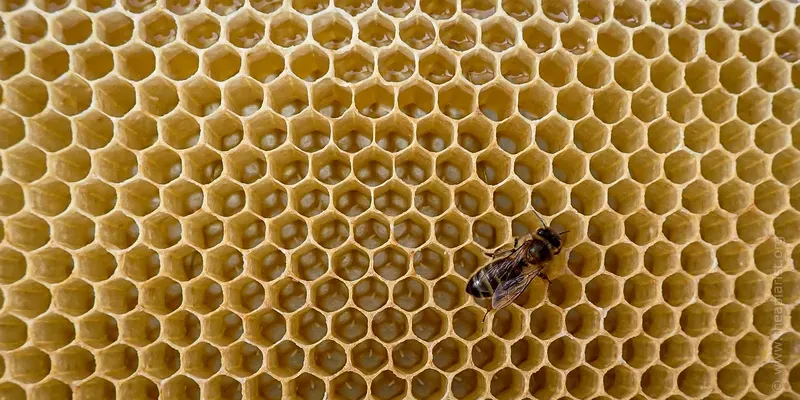
Remember, these queens are being superseded because the colony has determined that they aren't good enough. I've no idea how they determine this; is it pheromone levels, the laying rate, or the behaviour? {{4}}
An underperforming queen in high-season is a bit of a liability. Whilst I could let the colony requeen itself again, I don't think it's wise. If the potential supersedure is because the queen is poorly mated then it's likely that the range of sperm she has - either in volume or genetic variation - is limited. That's not a good starting point from which to rear a new queen.
There's also the delay to consider. The end of the season is fast approaching.
Which is where the new, mated queens in nucs come in, like the cavalry appearing over the crest of the hill in a Western.
By removing the 'dodgy' queen (and all the queen cells), and uniting the de-queened box with a queenright nuc, the colony experiences no interruption in brood production. Yes, I could just replace the queen, but what do I then do with the nuc box that's full of bees and brood?
So, how do you unite a nuc with a full hive?
As with almost all methods in beekeeping, there are numerous ways of achieving the same endpoint.
I'll briefly describe a couple of variants of the same method that I use, depending upon the time of the season, the state of the hive being requeened and the presence or absence of supers.
Simple uniting
A nuc has about half the number of frames in a full hive. Assuming there are no supers on the full hive, the simplest way to unite the two colonies is to use a second brood box, a sheet of newspaper and a fat dummy.
- Make sure the recipient hive is queenless and that there are no queen cells present.
- Cover the top bars of the brood frames with a single sheet of newspaper and make a very small hole somewhere in the centre {{5}}
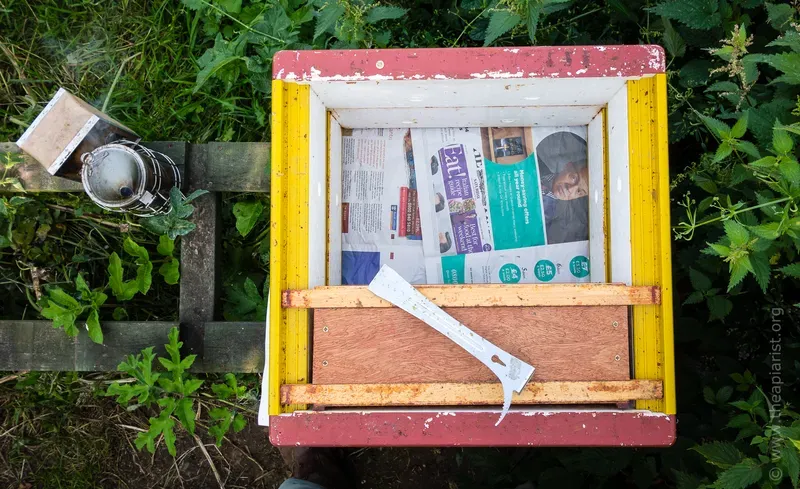
- Add a second brood box and a fat dummy.
- Transfer the five or six frames from the nuc into the space in the upper brood box. Move the fat dummy to correct the bee space around the added nuc frames.
- Add back the crownboard and roof and leave the colony undisturbed for a week.
Three additional tips:
- Don't use newspaper with staples holding the pages together. In the 'heat of the moment' you'll rip the sheets trying to separate the pages. Frustrating.
- When uniting like this I always put the moved colony on top ... I want the bees to realise that something has changed as they negotiate the lower brood box en route to the hive entrance as I believe {{6}} this encourages them to reorientate to the new location.
- Make absolutely certain that the queen was on one of the frames from the nuc, rather than wandering around on the sidewall of the nuc box {{7}}.
The bees chew their way through the newspaper, mix slowly and don't fight {{8}}.
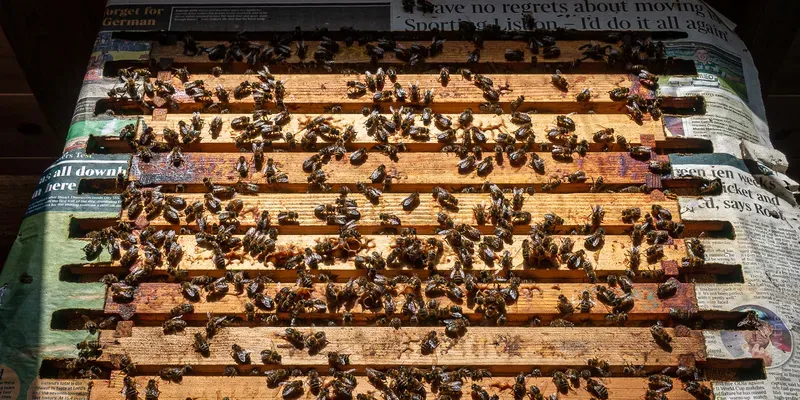
I have total confidence in this method and don't remember it ever failing.
Of course, that doesn't mean I always use it 😉.
Two into one does go
I prefer to overwinter my colonies in a single brood box. Uniting as described above leaves me with a double brood colony to compress into one box at the tail end of the season.
Not ideal. The winter cluster doesn't need that amount of space, and there are other things I'd prefer to be doing.
On inspecting one hive last week it was clear that the queen was underperforming. Although she wasn't (yet) being superseded, her laying rate was low and there were only about 3-4 frames of brood in the box. However, there were still a lot of workers, and the supers were reassuringly heavy.
Rather than creating a double brood colony, with lots of space in the bottom box, the logical thing to do was to add the nuc directly into the middle of the single brood box after removing sufficient empty frames.
I removed the supers and inspected the colony with the failing queen (and removed her). Fortunately, she was on the very first frame ... don't you love it when that happens?
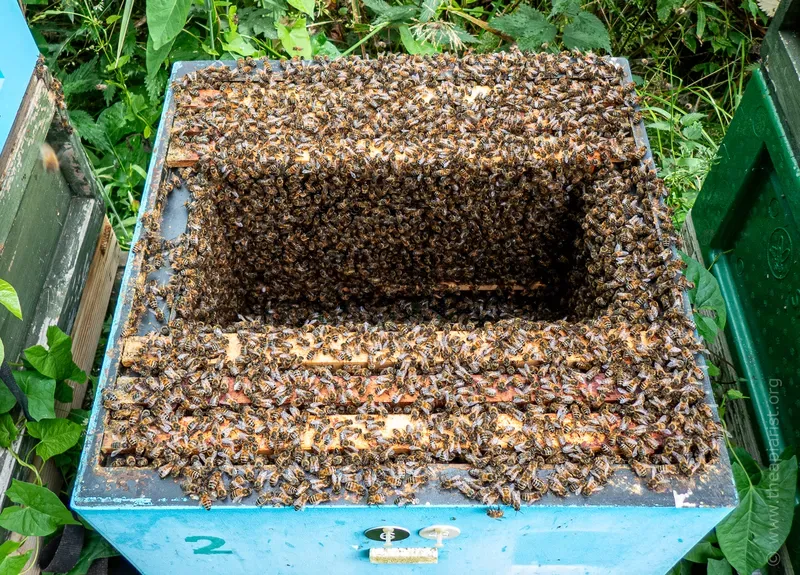
I then went through the box and removed five brood frames that were either empty or just contained nectar. I arranged the remaining frames on either side of a central void, with the 3-4 frames containing brood adjacent to the void.
The scent of success
To reduce any fighting I gave the prepared brood box a spray of air freshener to mask the scent of the hive.
The bees don't like this.
They don't get aggressive, but they do tend to boil out over the sides of the brood box. Don't overdo it ... or use an air freshener that's less pungent than the can in my bee bag.
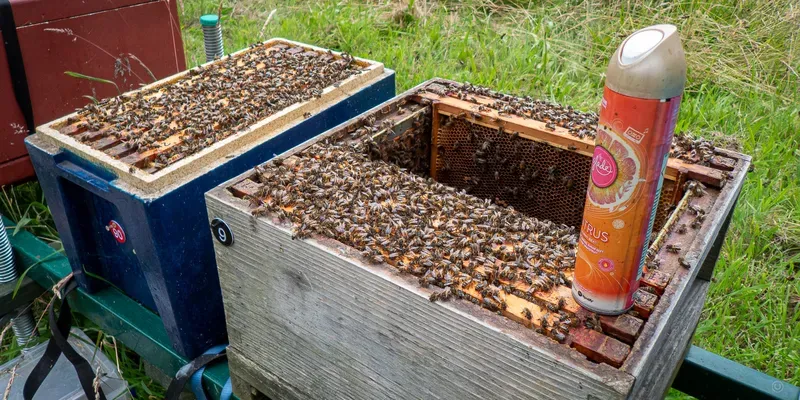
I then added the frames from the nuc into the prepared brood box, giving each frame a very quick spray with the air freshener.
As before, you must be certain that the queen was on one of the added frames. It really helps to have the queen marked so you can spot her quickly.
When I use this method, I always add the frame with the new queen in the middle of the frames added. If it's the first frame I pick out of the nuc box, it goes into the middle of the void, with the additional frames being added to either side.
The idea here is to surround the queen with her own bees for as long as possible, until the colony has mingled properly. However, to be honest, I've no idea if it really makes a difference where the frame with the queen goes.
What I do know is that the method works for me as described, and I'm not keen to potentially sacrifice a queen to determine whether modifications of this method also work.
Uniting supers
The hives I used this second method on last week all had supers on. Those supers were full of bees and nectar.
Do you need to give these a spray of air freshener as well? After all, they are going to be added directly on top of the nucleus colony added to the middle of the brood box.
Well, I guess you could, but I don't want to risk tainting the nectar with Glade's Odeur répulsive {{9}}.
I therefore unite the supers back with the 'merging' colony in the brood box using the newspaper method. This is probably 'belt and braces', but - again - I do it because it works for me.
By the time of the season I'm doing these sorts of hive manipulations I'm running out of time to get queens mated and get the colony up to strength for the winter. I therefore stick to a method I know works, rather than risking the queen.
Another method for supers
As an aside, if you simply want to unite two supers, or add a super containing bees and honey to a brood box full of bees, then use a crownboard with a single 8 mm hole in the middle.
Dave Cushman describes this method - and why it works - nicely.
Of course, I don't have a special crownboard with an 8 mm hole in it.
That would be silly.
I've got a bog-standard crownboard and a small piece of plywood with an 8 mm hole that covers one of the Porter escape holes in the crownboard.
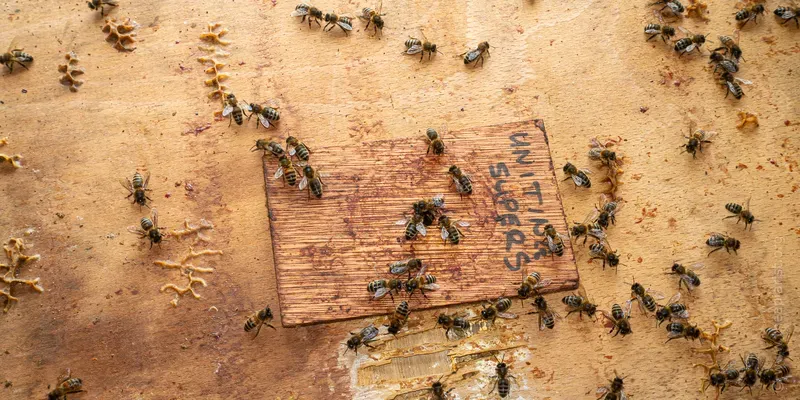
I suppose I could have used this method in place of the newspaper ... except, there's a nectar flow on, and I'm not going to be back in the apiary for a fortnight. This setup needs to be removed after a couple of days at most.
The last thing I want is for the bees to backfill the brood box with nectar because there's so much congestion around the 8 mm hole leading to the supers.
Where would their new queen lay?
And finally
I used the same method of uniting a nuc into a single brood box with a colony that had killed (or lost) its mated queen and that I suspected - correctly as it turned out - had a virgin queen scurrying around inside it.
But could I find her?
I removed the excluder and set it aside before carefully going through every frame.
No sign of her.
Having removed a number of frames I then peered into the corners of the brood box. Virgins don't move about like mated queens, and often don't stick to brood-containing frames. They can be anywhere.
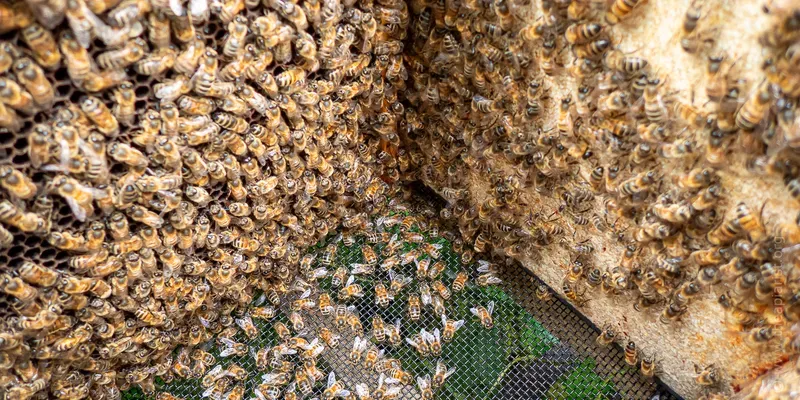
No sign of her.
I then separated the remaining frames, let them settle and re-inspected them carefully {{10}}.
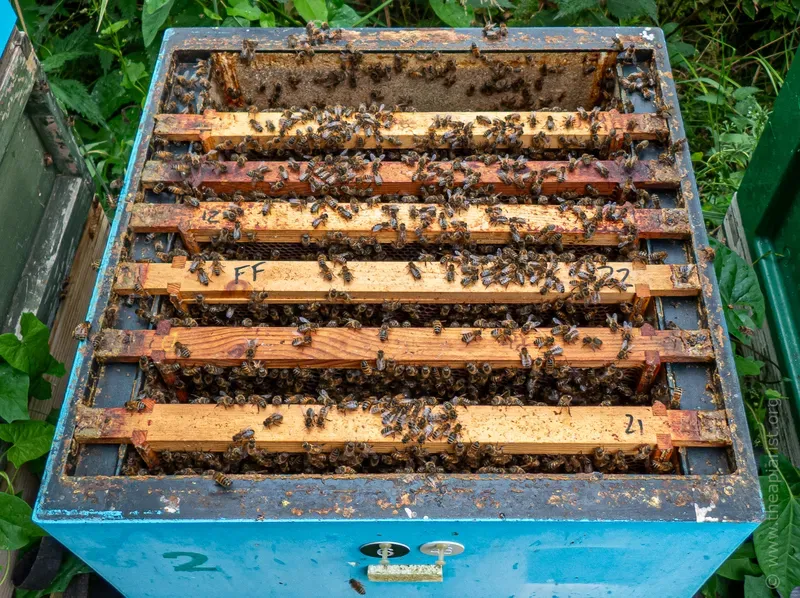
No sign of her.
I looked again in the deepest, darkest recesses of the box ... and then, finally, checked the queen excluder.
Ta da!
How many times have I told beginners to always check the queen excluder for the queen before setting it aside?
Having taken this quick video of the queen scuttling about, partly for this post and partly to remind me of my stupidity, I picked her up to apply the coup de grâce ...
... and was promptly stung on the palm of my hand by a lurking worker. It's a surprisingly painful location to be stung. I dropped the queen who, being a virgin, could probably fly perfectly well ... and never saw her again, despite searching the grass all around.
D'oh!
I continued with the uniting - after all, I had an overcrowded nuc box and a queenless (though perhaps only briefly) colony - and will find out next time whether the virgin returned and slaughtered my introduced queen.
Don't do as I do, do as I say 😉.
Sponsor The Apiarist ...
... you know it makes sense. This site exists thanks to hundreds of late nights and the caffeine from "double-shot" cappucino's coursing through my veins.
If this post, or others (there are hundreds to choose from), has helped or inspired your beekeeping, or was just amusing (surely not?), then please consider sponsoring The Apiarist. Sponsorship costs less than £1/week annually. Sponsors receive the weekly posts, an irregular monthly newsletter (Bees in the News), and sponsor-only content ... like the recent post on resistance to Apivar.
Alternatively, you can help alleviate my caffeine withdrawal symptoms ... and, whether you are a supporter or not, please spread the word to encourage other beekeepers to subscribe.
Notes
To avoid the ever-present AI site scrapers which copy, butcher and regurgitate the original content I've sweated over for hours, I will increasingly be making some of the web content available to subscribers only - whether free or paid. If you are a subscriber (free) or sponsor (paid) you will still receive the emailed newsletter but, if you want to view the post in a web browser to get the footnote pop-ups, you will need to sign-in first. Free-to-view content will still be free-to-view, but it will help stop an unnamed purveyor of beekeeping equipment in Australia (and others) from lifting my content and re-presenting it as their own.
Perhaps I should write a damning review of their products or customer service and see if they copy that as well?
😃.
{{1}}: I'll be unloading the pantechnicon as this post appears in your email INBOX.
{{2}}: The scout bees may well have already located a new nest site, so setting up a bait hive once the swarm has left is usually a futile exercise.
{{3}}: Or less.
{{4}}: Or any of a gazillion other things I've either not listed or that we are blissfully unaware is of importance to, and measurable by, the bees.
{{5}}: On a very windy day this can be a frustrating procedure. You can pin the paper down to the sides of the brood box or add a queen excluder over the sheet of newspaper.
{{6}}: With no evidence whatsoever!
{{7}}: Yes, you guessed it. I learned this the hard way ... if you don't do this you may lose the queen when you shake the - now empty of frames but not of bees - nuc box over the hive. Since you moved the nuc, the queen will not return, at least not to the hive being united. And, if she's clipped, she won't return at all.
{{8}}: How do we actually know this?
{{9}}: Sounds classier in French and an Olympic reference.
{{10}}: This trick might work with a mated queen, but virgins are a lot less attractive to the workers, so they don't congregate calmly on the queen-containing frame.

Join the discussion ...